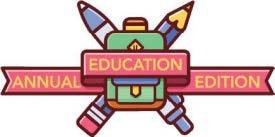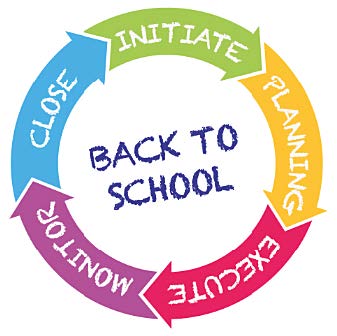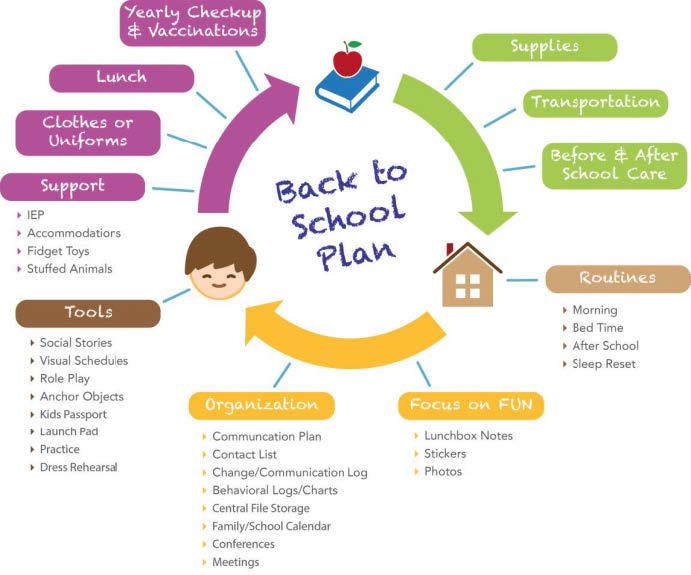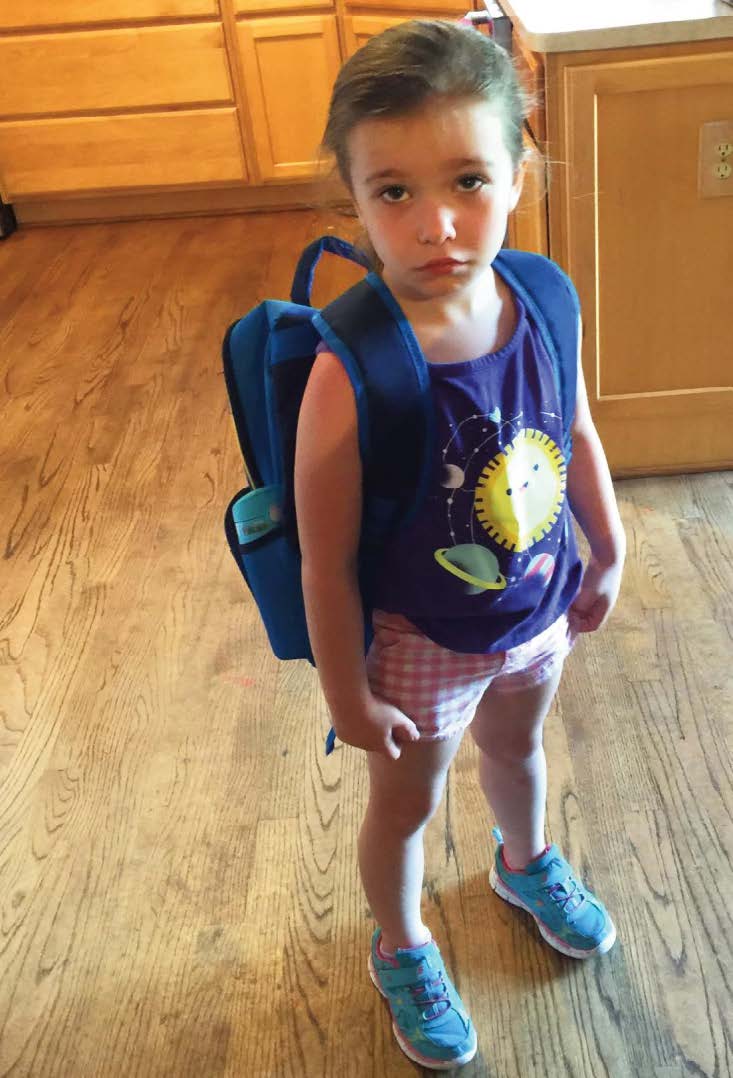
The Exceptional Parent's Planning Guide
BY JACKIE SCHWABE
Knowing one child with special needs means only that you know that child. If you meet my daughter Zoe, you would know a child with autism; yet knowing Zoe likely won't prepare you to have a positive experience with the next kiddo you meet on the spectrum.
There isn't a one-size-fits-all approach to helping children who have special needs. This rule holds true even when preparing to send your kiddo back to school in the fall. But how do you sift through the mountain of resources, checklists, and articles available on the web to find the tips and pointers that will work best for your child?
I learned early on that finding a good way to do one thing often leads to a good way to do many things. In addition to being Zoe's mom, I'm a project manager by trade and experience, so perhaps it's no surprise I turned to project management tools to help me prepare her to go back to school.
The Project Management Body of Knowledge (PMBOK) Guide (5th ed.) documents a standard methodology and describes five phases for successful execution of any project. One day it occurred to me that preparing Zoe for her first day of school involves all the elements of a project. As that light dawned, I thought, why not use a method already proven in the business world to kick butt in my personal life?
The purpose of this article is to show you a way to sort through the mountains of advice available to you and empower you to create a unique back-to-school plan to meet the unique needs of your child. The five phases of the project lifecycle have been incredibly helpful to me, so I want to share them here to help you and your kiddos have a great first day of school.
Whose Line is it Anyway?
To me, the start of each school year often feels like a really bad episode of the improvisational comedy show "Whose Line Is It Anyway?" Like everyone just grabs a bunch of random topics out of a hat, then the teachers or bus driver determine the prompts for Zoe – and we get to live with the not-so-comedic aftermath. Other times it feels like back to school is a brutal game of Wheel of Fortune. We spin the wheel and see what we'll forget this year that will send Zoe into complete meltdown.
Last year was her first year of traditional school. My husband and I have three other children, so we assumed we had the whole starting a new school thing under control. I did a few Internet searches, pulled together some tips and pointers, and figured I would just sail right through. I should have considered my nearly two decades of business experience to remind me that failing to plan results is planning to fail. I learned several valuable lessons about planning. By passing them along I hope I can help you have a better start this year too. If any of these scenarios feel even vaguely familiar, then this article is for you. I will guide you through using the five phases of the project lifecycle, so you can use them to help your kiddos have a great first day of school.
Initiate: 3, 2, 1… Blast Off!
Sometimes that hardest part of planning for a new school year is starting. The Initiate phase of a project is essentially just that, starting the process. It is the 3 in 3, 2, 1… Blast off! Unfortunately, one of the things folks often forget to consider when planning is to define the outcomes they want to achieve.
This year I got specific about the outcomes I wanted in Zoe's back-to-school plan. I wanted to ensure she had all of the supplies she needed, that transportation to and from school was established, that she had routines established before school started, and that useful tools and resources to support her behavioral and academic goals were organized and easily accessible.
Knowing the outcome helped me set a few boundaries and guidelines on the project. I love to collect resources, even if I don't need them at the time, so I established an appropriate budget to ensure I didn't go crazy with all the cute animal cutouts. Since money doesn't grow on trees (at least not in Wisconsin), I also set a total budget for our back-to-school project. It included school clothes, supplies, resources, and whatever else I identified during the project planning phase.
In addition to defining the outcomes and the budget, I took time to consider who all the stakeholders, or interested parties, on the project would be. This included teachers, therapists, bus drivers, etc. I made a list of all the people who might need to know information or be involved and accessible to everyone on our back-toschool team.
Planning: Planning for Success
Once you know the outcomes you are planning to achieve, it is easier to plan. In a nut shell, planning is figuring out how the project will be carried out, who will do the work, and how long it will take. The one easy thing about planning for back to school is "DDay" is known. So, all my planning started with the end date in mind and I worked backward from there.
The traditional Planning phase includes a few knowledge areas to consider: defining what success looks like, setting the scope of the project, establishing boundaries or limits to work within, and identifying deliverables you want to produce. This gives you what you need to set a schedule of tasks and refine the budget (by task if appropriate).
FIVE PHASES OF LIFE EVENTS AS A PROJECT

INITIATE
Initiation is the phase that kicks off planning the project. This is the time to identify specific goals you want to achieve, begin thinking about the budget for your project, and identify all the participants.
PLANNING
Having a solid plan won't eliminate all risks but does help identify and mitigate many of them. This phase is the time to imagine what success will look like and establish the scope of the project. During the planning phase you also will identify boundaries or limitations that apply to your situation, prioritize items you'll need to deliver, create a schedule, clarify and assign tasks, set a budget, define the roles of everyone involved in the project, identify key risks, and decide what needs to be purchased. This is also the time to start thinking about how change will be handled – because no plan survives first contact with reality!
EXECUTION
This is the getting-it-done phase. This is when you'll follow the plan and adjust it as needed along the way. You'll do the things you always do as the project manager of your home and your child's life: guide, direct, and support your team, make sure things get done when they need to be done, and manage the budget.
MONITOR AND CONTROL
This is the phase for monitoring the schedule, budget, and quality of work to ensure everything gets done to your standards. You will track the costs, drive schedules, and monitor the scope of the project to be sure it doesn't creep, grow, or get off track. Communication throughout this phase will be constant to make sure all participants stay focused on their responsibilities and have the resources they need to ensure the team succeeds.
CLOSE
This is the wrapping-it-up phase. You'll check the books to see if you were on time and within budget, store any useful tools or notes for future use, free up any resources (including people!) no longer needed on the projects, and document any lessons learned. It is also the perfect time to celebrate success.
Finally, team members need to understand their roles, responsibilities, and how to contact each other when needed. When setting expectations for the team, be sure to explain the quality you require, identify risk areas, make a list of items you need to purchase, and – perhaps most important – make sure everyone knows how to deal with unanticipated change or disruption.
What Does Success Look Like?
One of the reasons many "Top 10" lists were not helpful for Zoe was we didn't define success the same way the authors did. Success for us meant having all her supplies, transportation, support, routines, and tools acquired, organized, and easily accessible. That meant articles about how to navigate the IEP process from start to finish, or how to discuss puberty and body positivity for a high schooler with an autism diagnosis, didn't help us meet our goals. Knowing what you are trying to accomplish and what success looks like for your child helps planning go smoothly and gives you a framework to prioritize and curate the mountains of information available to you.
What is the Scope of the Project?
The scope of a project includes project goals, deliverables, tasks, deadlines, and costs. It is a description of what needs to be done to deliver the success you envisioned for your child. Essentially, scope includes the knowledge areas discussed above for a project the size we are describing.
Defining the scope helps keep you on track. Understanding the problem, you are trying to solve can be a real time, money, and sanity saver. If your scope is to create positive morning and bedtime routines for your child, then a 200-page eBook on how to navigate the IEP may not be a resource you need to purchase right then. Tempting as it may be to learn and know all there is to know, we only have so much time and so many resources to work with. Knowing your scope helps maintain focus on goals, keep eyes on the ball, and execute the plan.
What Are the Boundaries or Limits You Have To Work Within?
Knowing our desired result, what success looks like, and the scope of our project is a great start. Another way to help keep us on track is to know the boundaries of limits within the project. One example might be that your child cannot attend after-school care at their public school because it cannot support their individual needs. Knowing these boundaries allows you to plan around them. For example, three of my children get out of school at 3:10 pm, but Zoe gets out of school at 2:20 pm and her bus arrives at our house at 2:40 pm. Zoe's school has an afterschool care program from 2:20 pm to 5pm for $40 a week. The school the rest of our kids attend also has an after-school program from the end of the school day to 6:00 pm for $5 per child per hour. Those time and budget factors are all boundaries that guide my husband and me in making the best decision for Zoe and our family to fill the gap between the end of the school day and when we return from work. We know all the key limits and can make informed decisions to support our desire outcome.

BACK TO SCHOOL RESOURCE CORNER
When you plug keywords "back to school kids special needs," approximately a bazillion articles pop up. Search results return articles about anti-bullying, IEP Checklists, routines, and more. I read more than 15 articles to prepare for the start of our last school year and each was essentially a list of things a particular parent or agency felt were important from their perspective. Don't get me wrong, most of the resources had value – but I needed a Back-to-School Plan for Zoe. Of the resources I researched, here are the four most relevant to Zoe and me.
READING ROCKETS Tips for Back to School bit.ly/BTSReadingRocketsTips
MOM BLOG 25 Tips for Back to School Supplies bit.ly/BTSSupplies25Tips
Autism Speaks Toolkits for Back to School bit.ly/BTSAutismSpeaksTips
FRIENDSHIP CIRCLE Back to School Blog Series bit.ly/BTSFriendshipCircleSeries
What Are the Deliverables You Want To Produce/Tasks You Want to Complete?
Produce/Tasks You Want to Complete? Success, scope, and boundaries were missing from most every article I researched on back-to- school planning, but there was no shortage of lists on tasks to consider. The reason there are so many of these types of articles and resources is we all have different children, desired outcomes, definitions of success, scopes, and boundaries.
That leaves us with the million-dollar question: How do we identify all the tasks we need to get done?
One method I find useful for the productive brainstorming of tasks in a project is to define the main actors and their relationships with each other, then use a technique called mind-mapping to brainstorm a list of tasks that must be completed to achieve the outcome of my plan.
Your eyes may be glazed over right now, but never fear! This is both the most powerful and the most fun part of the process. I shared am image of our own mind map here as an example. The three categories of participants are our children, school personnel, and my husband and me. Based on those three actors, our roles and relationships, and the outcomes we want to achieve, we identified the big areas to consider: supplies, transportation, routines, focus on fun, organization, tools, support, clothes, lunch, and yearly checkups.
Once we had the big ideas listed, we created little ideas from the big ones. The end result was all the big and small ideas came together to form our list of tasks to complete the project plan.
Mind mapping is the secret sauce when making a personalized back-to-school plan for your child. Once you list all the tasks from a mind map, you can assign a person to complete each one. If you are the person who will do all of the tasks, I recommend you don't worry about putting a schedule or timeline next to every task – just create a checklist for yourself and mark things off as you accomplish them.
You can use the checklist to take you to the next level if you have others helping you with the overall project. Just add a column for who is assigned the task and when it is due. Be sure to let them know the tasks and dates they need to be completed. And as I said before, one way to determine when a task needs to be done is to identify D-Day and work backwards to the present date. Fill in a task from the checklist in the date on a calendar page with the responsible person's name. You can accomplish this in lot of ways using a range of different tools, but for the sake of simplicity you can also just print off a blank calendar page and write in the tasks by hand.
What Else Do We Need To Do that Might End Up Being a Task You Want To Complete?
Once you brainstorm tasks as I described, you are well on your way to a solid plan. However, a few other things must be considered. At our house we like to say we presume competence, but plan for being wrong. Be sure to look into any areas that are likely to be high risk and create a task to mitigate those risks. You can also consider creating a list of items you need to purchase, where they can be found, and any specific ways to deal with changes or disruptions to your plan.
In our case we know changes to Zoe's routine can be a disaster. To mitigate this risk, we create social stories as part of our planning process that deal with potential changes. This allows us to plan ahead, anticipate disruption, and mitigate the fallout.
Execution: Get'er Done!
This is the getting it done phase. If you have created a checklist and made a schedule using a calendar page, spreadsheet, or whatever format you prefer, this part is the relatively easy one.
Use your planning document to focus on your tasks and manage those assigned to other members of your team. You can adjust as needed on the fly because you understand the overall scope of your project and the outcomes you want to achieve. This phase can be the easiest phase of all – fun even – if you treat it like a project manager would treat it. After all, you are doing what you always do as the project manager of your home and family. You are directing yourself and your team to make sure things get done on time and within budget.
Monitor&Control: Inspect What You Expect
During this phase, ensure work gets done to your standards. Inspect what you have delegated to others to make sure you are getting what you expected. This includes monitoring the schedule, budget, and quality along the way. Remember to check in with the members of your team regularly and make sure communication continues to flow in both directions.
Close: Back to School!
This is the wrapping it up phase. Successfully getting your kiddo to school is just a beginning and your next project will probably start right away. So, learn from what worked – and what didn't! – but be sure to take a moment to celebrate your success together with your team. In my case, I try to celebrate with a nap.
That's a wrap! Hopefully you feel you can now use the Initiate, Planning, Execution, Monitoring, and Close phases of project management to plan a successful back to school day for your unique and wonderful child. Enjoy the new school year!
ABOUT THE AUTHOR: Jackie Schwabe is co-founder and CEO of Mindlight, LLC and Vice President of Leadership Research at North of Center. She is a certified Caregiving Presenter, Certified Caregiving Consultant, and Certified Caregiving Educator. She received her BA in Management Computer Systems from the University of Wisconsin – Whitewater and her MBA in Technology Project Management from the University of Phoenix. She has been active in the area of healthcare integration, healthcare IT, telemedicine, product development, and product management for over 20 years. She has been a cross-sector, cross-discipline leadership practitioner her entire career. Her mission, to provide the tools, opportunities, and connections people need to be their best self.
INEXPENSIVE SOLUTIONS WE LOVE : FALLOUT MITIGATION
HELLO INTERVENTION Back to School Social Stories are great! bit.ly/BTSHelloIntervention
AUTISM CLASSROOM Loved the Social Skills Bundle! bit.ly/BTSAutismClassroom
TEACHING SPECIAL THINKERS Back to School for Autism is my Fav! bit.ly/BTSSpecialThinkers
ONE GIGGLE Awesome Back to School Social Stories! bit.ly/BTSOneGiggle

DRESSED FOR SUCCESS: One of the reasons many "Top 10" lists were not helpful for Zoe was we didn't define success the same way the authors did. Success for us meant having all her supplies, transportation, support, routines, and tools acquired, organized, and easily accessible.